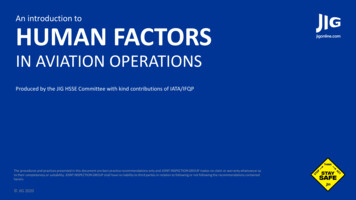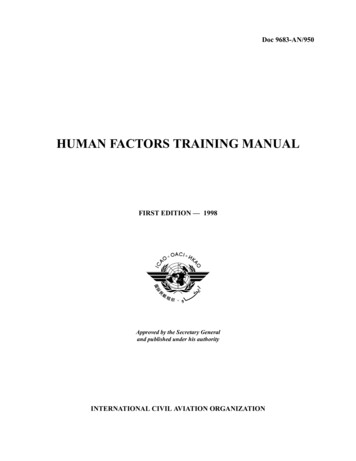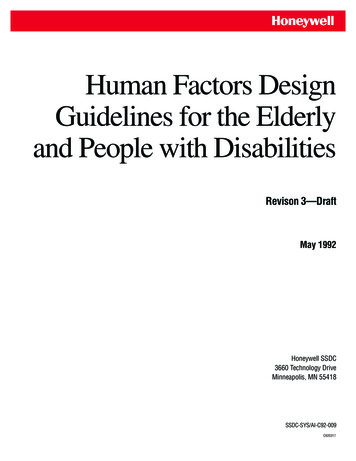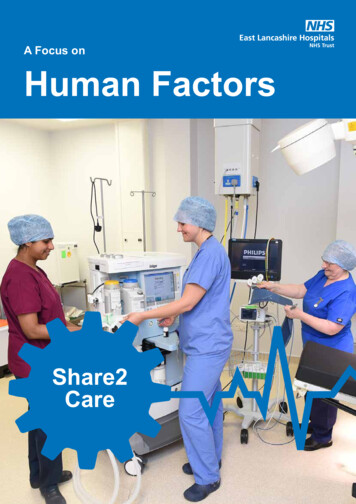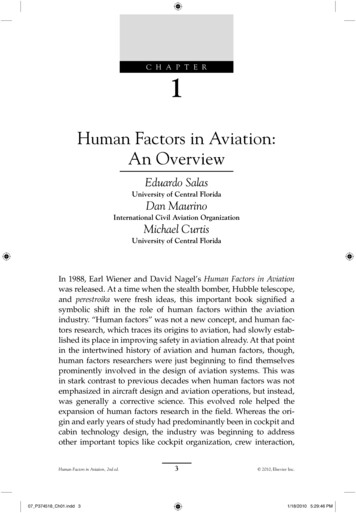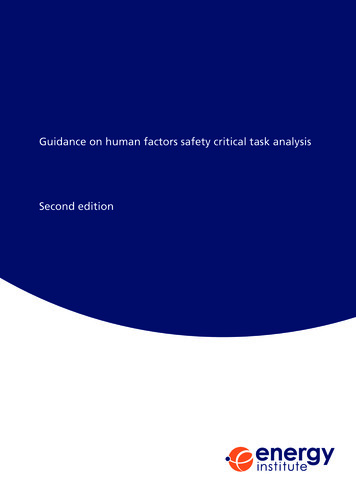
Transcription
Guidance on human factors safety critical task analysisSecond edition
GUIDANCE ON HUMAN FACTORS SAFETY CRITICAL TASK ANALYSISSecond editionJanuary 2020Published byEnergy Institute, LondonThe Energy Institute is a professional membership body incorporated by Royal Charter 2003Registered charity number 1097899
The Energy Institute (EI) is the chartered professional membership body for the energy industry, supporting over 20 000 individualsworking in or studying energy and 200 energy companies worldwide. The EI provides learning and networking opportunities to supportprofessional development, as well as professional recognition and technical and scientific knowledge resources on energy in all its formsand applications.The EI’s purpose is to develop and disseminate knowledge, skills and good practice towards a safe, secure and sustainable energy system.In fulfilling this mission, the EI addresses the depth and breadth of the energy sector, from fuels and fuels distribution to health and safety,sustainability and the environment. It also informs policy by providing a platform for debate and scientifically-sound information on energyissues.The EI is licensed by: the Engineering Council to award Chartered, Incorporated and Engineering Technician status, and the Society for the Environment to award Chartered Environmentalist status.It also offers its own Chartered Energy Engineer, Chartered Petroleum Engineer, and Chartered Energy Manager titles.A registered charity, the EI serves society with independence, professionalism and a wealth of expertise in all energy matters.This publication has been produced as a result of work carried out within the Technical Team of the EI, funded by the EI’s Technical Partners.The EI’s Technical Work Programme provides industry with cost-effective, value-adding knowledge on key current and future issuesaffecting those operating in the energy sector, both in the UK and internationally.For further information, please visit http://www.energyinst.orgThe EI gratefully acknowledges the financial contributions towards the scientific and technical programme from the following companies:BP Exploration Operating Co LtdQatar PetroleumBP Oil UK LtdRepsol SinopecCentricaRWE npowerChevron North Sea LtdSaudi AramcoChevron Products CompanyScottish PowerChrysaorSGSCLHShell UK Oil Products LimitedConocoPhillips LtdShell U.K. Exploration and Production LtdDCC EnergySSEEDF EnergyTAQA BrataniENITotal E&P UK LimitedE. ON UKTotal UK LimitedEquinorTullow OilExxonMobil International LtdUniperInnogyValeroKuwait Petroleum International LtdVattenfallNexen CNOOCVitol EnergyØrstedWoodsidePerencoWorld Fuel ServicesPhillips 66However, it should be noted that the above organisations have not all been directly involved in the development of this publication, nordo they necessarily endorse its content.Copyright 2020 by the Energy Institute, London.The Energy Institute is a professional membership body incorporated by Royal Charter 2003.Registered charity number 1097899, EnglandAll rights reservedNo part of this book may be reproduced by any means, or transmitted or translated into a machine language without the writtenpermission of the publisher.ISBN 978 1 78725 165 6Published by the Energy InstituteThe information contained in this publication is provided for general information purposes only. Whilst the Energy Institute and thecontributors have applied reasonable care in developing this publication, no representations or warranties, express or implied, are madeby the Energy Institute or any of the contributors concerning the applicability, suitability, accuracy or completeness of the informationcontained herein and the Energy Institute and the contributors accept no responsibility whatsoever for the use of this information. Neitherthe Energy Institute nor any of the contributors shall be liable in any way for any liability, loss, cost or damage incurred as a result of thereceipt or use of the information contained herein.Hard copy and electronic access to EI and IP publications is available via our website, https://publishing.energyinst.org.Documents can be purchased online as downloadable pdfs or on an annual subscription for single users and companies.For more information, contact the EI Publications Team.e: pubs@energyinst.org
GUIDANCE ON HUMAN FACTORS SAFETY CRITICAL TASK ANALYSISCONTENTSPageForeword 6Acknowledgements 71Introduction 81.1 Background 81.2 What is safety critical task analysis? 81.3 Benefits 101.4 Purpose 101.5 Scope 111.5.1Focus on qualitative approaches 111.5.2Other approaches to task analysis 111.5.3SCTA and routine task risk assessment 112Safety critical task analysis process 122.1 Overview 122.2 Step 1 – Identify main site hazards 132.3 Step 2 – Identify and prioritise safety critical tasks 132.3.1Capturing SCTs at the right level 142.3.2Identifying tasks 152.3.3Screening and prioritising tasks 182.3.4What types of task are of interest? 202.3.5Defining required actions 212.3.6 Common pitfalls, misunderstandings and misapplications – andtheir solutions 212.4 Step 3 – Understand the tasks 242.5 Step 4 – Represent the safety critical tasks 262.6 Step 5 – Identify human failures and performance influencing factors 292.6.1Group-based approaches 302.7 Step 6 – Determine safety measures to control risk of human failures 322.8 Step 7 – Implement and monitor effectiveness of safety measures 342.9 Step 8 – Review the effectiveness of the process 342.10 SCTA techniques and output summary 352.11 Illustrative examples of outputs 352.12 Frequently asked questions 403Supporting methods and techniques 423.1 Hierarchical task analysis 423.1.1Brief description 423.1.2Applicability 423.1.3Pros and cons 423.1.4Examples and further reading 433.2 Human HAZOP and team/guideword based variants 433.2.1Brief description 433.2.2Applicability 443.2.3Pros and cons 443.2.4Examples and further reading 443.3 Other techniques 443.3.1Fault tree analysis 443
GUIDANCE ON HUMAN FACTORS SAFETY CRITICAL TASK ANALYSISContents continuedPage3.3.23.3.33.3.43.3.53.3.6Event tree analysis 46Bow tie analysis 47Layer of protection analysis (LOPA) 48Integrating SCTA into daily operations 49Additional techniques 514Case studies 524.1 Case study 1 – Identifying SCTS at a refinery 524.2 Case study 2 – Identifying SCTS at another refinery 524.3 Case study 3 – Identifying SCTS for a series of mature offshoreproduction platforms 554.3.1Operations 554.3.2Maintenance 554.3.3Process upsets 564.3.4Emergency response 564.3.5Decommissioning 564.4 Case study 4 – Using task screening to identify safety critical sub-tasks 574.5 Case study 5 – Chemical offloading operation 574.6 Case study 6 – Power plant control room operation 595High- versus low- quality SCTA 635.1 How to recognise a high quality SCTA 635.2 How to recognise a low quality SCTA 63AnnexesAnnex AExamples of supporting material 65Annex BReferences and bibliography 76B.1References 76B.2Bibliography 78Annex CAbbreviations and accronymns 794
GUIDANCE ON HUMAN FACTORS SAFETY CRITICAL TASK ANALYSISLIST OF FIGURES AND TABLESPageFiguresFigure 1Figure 2Figure 3Figure 4Figure 5Figure 6Figure 7Figure 8Figure 9Figure 10Figure A.1Summary of SCTA process 12Example simple criticality/prioritisation tables and matrix 19Data collection techniques 24Example HTA diagram 28Mapping techniques to SCTA steps 35Simplified tanker unloading example 45Associated fault tree 46Example event tree analysing MAH escalation 47Partially developed bow tie 47Human error as a degradation factor, highlighting ‘start-up’ as an SCT 48Example risk-based operating task classification guide 75TablesTable 1Example procedure screening matrix for a LPG bulk storage/distribution site 17Table 2Example simple criticality/prioritisation table 19Table 3Blockers to SCT identification and potential enablers 22Table 4Example human failure identification guidewords 29Table 5Mapping effective safety measures against human failure classification 32Table 6Example of emergency response task analysis 36Table 7 Example of task analysis relating to accident initiation – operations – roadtanker loading at fuel terminal 37Table 8 Example of task analysis relating to accident initiation – maintenance –pipeline interventions 38Table 9 Examples of task analysis relating to accident escalation – detection,control and mitigation of events 39Table 10Illustrative ALARP demonstration 40Table 11TIP outline 50Table 12Operational SCTs 53Table 13Maintenance, inspection or testing tasks 54Table 14Emergency response tasks 54Table 15Summary of case study 5 58Table 16Example output from human HAZOP 59Table 17Summary of case study 6 60Table 18Example output from nuclear power station SCTA 62Table A.1Performance influencing factors 65Table A.2Alternative checklist of performance influencing factors 66Table A.3 Example adaptation of the HSE’s 5-item task criticality scheme – coveringenvironmental hazards, posed by loss of containment 68Table A.4 Example task criticality scoring for tasks involving handling or useof hazardous substances 69Table A.5Example human HAZOP guidewords 715
GUIDANCE ON HUMAN FACTORS SAFETY CRITICAL TASK ANALYSISFOREWORDThe human contribution to major accident hazard (MAH) risk in the energy and allied industries iswell-known. In recent years, the sector has made significant inroads in both the management ofhuman failure, and in optimising human performance. In part this can be attributed to applicationof the first edition of the Energy Institute's (EI) document Guidance on human factors safety criticaltask analysis (SCTA). Originally published in 2011, the first edition filled a gap by enabling companiesand human factors (HF) non-specialists to conduct quality HF analyses in a structured and consistentformat. The document raised awareness of the value of investing in HF studies to better manage therisk of human failure, leading to reported improvements in safety and reductions in losses. Regulatorsalso recognise that its correct application will help satisfy requirements for safety critical tasks to becomprehensively analysed and their risk appropriately assessed.This second edition of the guidance has been updated, focusing on the identification of safety criticaltasks (SCT). Feedback to EI's Human and Organisational Factors Committee (HOFCOM), as custodianof the guidance, confirms that users would benefit from learning more about the range of methodsfor SCT identification that has been developed, and how to avoid pitfalls. New case studies areincluded in section 4 to show how companies have identified SCTs.This publication has drawn on many existing sources from the public domain, and has supplementedthese with input from practitioners and case study material. It is aimed at those who: participate inSCTA; incorporate SCTA into a wider risk assessment; commission SCTA, and those that are requiredto read, understand and act upon SCTA. Thus, the target audience includes designers, operationspersonnel, assessors and managers.The information contained in this document is provided for general information purposes only.Whilst the EI and the contributors have applied reasonable care in developing this publication, norepresentations or warranties, expressed or implied, are made by the EI or any of the contributorsconcerning the applicability, suitability, accuracy or completeness of the information contained hereinand the EI and the contributors accept no responsibility whatsoever for the use of this information.Neither the EI nor any of the contributors shall be liable in any way for any liability, loss, cost ordamage incurred as a result of the receipt or use of the information contained herein.The EI welcomes feedback on its publications. Feedback or suggested revisions should be submitted to:Technical DepartmentEnergy Institute61 New Cavendish StreetLondon, W1G 7ARe: technical@energyinst.org6
GUIDANCE ON HUMAN FACTORS SAFETY CRITICAL TASK ANALYSISACKNOWLEDGEMENTSGuidance on human factors safety critical task analysis (second edition) was developed by Dr. EdSmith and Richard Roels (DNV-GL) under direction of the EI HOFCOM. During this project, HOFCOMmembers included:Tony AtkinsonJonathan BohmRoger BresdenEd CorbettAlix DaviesBill GallPeter JefferiesStuart KingSimon MonningtonEryl MarshRichard MarshallRob MilesHelen RycraftCaroline MyersRob SaundersGillian VaughanFrank VerschuerenPhil SpenceABBHSESaudi AramcoHSLEDFKingsley Management Ltd.Phillips 66EI (Secretary)BP plcHSEEssar Oil UK (Vice-Chair)Hu-Tech Risk Management Services Ltd.IAEAExxonMobil CorporationShell InternationalEDF Energy (Chair)FOD WASOConocoPhillipsProject management and technical editing were carried out by Stuart King (EI).The EI would also like to acknowledge the following individuals and organisations who commentedon, provided resources, or otherwise made significant contributions to the second edition:Phil BasildonGillian HockinDavid JamiesonEd JamiesonVitor MonteiroRWEBPShellRWEBPFurthermore, the EI would also like to acknowledge the following individuals and organisations whocommented on, provided resources, or otherwise made significant contributions to the first edition:Wayne BarrattAndy BrazierAllan GreensmithJamie HendersonChris VennRhodiaAB Risk Ltd.Total Lindsey Oil RefineryHuman Reliability AssociatesChevronBP LPGBP Chemicals Limited Hull SiteConocoPhillips Humber RefineryHuman Reliability AssociatesAffiliations are correct at the time of contribution.7
GUIDANCE ON HUMAN FACTORS SAFETY CRITICAL TASK ANALYSIS11.1INTRODUCTIONBACKGROUNDThere is widespread awareness in the energy industry that human failures whilst performingSCTs have contributed to major accidents, such as Macondo, Piper Alpha, Chernobyl andTexas City. The proactive identification and analysis of such SCTs has improved in recent yearsreflecting increased awareness and acceptance of the value of looking at such activities indetail, using the SCTA process. This growth is due to: significant uptake of the first edition ofthis guidance; the recognition that purely technical approaches to safety have their limitations,and through ongoing regulatory support.1.2WHAT IS SAFETY CRITICAL TASK ANALYSIS?Task analysis can be simply defined as the study of what a person is required to do, in termsof actions and mental processes, to achieve a goal (Kirwan and Ainsworth, A guide to taskanalysis). It involves describing how a task is done, often through a series of smaller subtasks. SCTA focuses on how tasks that are critical to major accident risk are performed. Thefollowing is a definition of an SCT: An SCT is a task where human factors could cause, or contribute to, a major accident1,or fail to reduce the effect of one, including during: operational tasks; prevention and detection; control and mitigation, and emergency response.Using these headings, the following show illustrative SCTs identified by practitioners: Operational tasks: loading liquid petroleum gas (LPG) from bulk storage to road tanker; sampling of hazardous substances, and blinding/de-blinding of piping and equipment. Prevention and detection: test level trips, and override or suppress safety function (e.g. inhibit fire or gas detectors). Control and mitigation: pressure safety valve (PSV) inspection and testing, and firewater pump inspection and testing. Emergency response: deploy active firefighting equipment (to fight fire), and launching a lifeboat.1 Control of Major Accident Hazards (COMAH) Regulations: 'major accident' means an occurrence such as a majoremission, fire, or explosion resulting from uncontrolled developments in the course of the operation of any establishmentto which these regulations apply, and leading to serious danger to human health or the environment (whether immediateor delayed) inside or outside the establishment, and involving one or more dangerous substances (COMAH Regulations2015)8
GUIDANCE ON HUMAN FACTORS SAFETY CRITICAL TASK ANALYSISSCTs, like the ones listed, will have several critical sub-tasks that require analysis. Moreinformation about identifying SCTs is given in 2.3.1.The process of SCTA includes: determining which tasks are safety critical;prioritising SCTs for analysis;understanding which human action or inaction might make a failure more likely ormore serious, andguiding the user in how to identify and install adequate layers of protection for theseSCTs, in order to reduce the likelihood or consequences of human failure.SCTA normally links to the type of MAH safety analysis that would be conducted at a projectdesign stage or for safety report/safety case updates2 and is often done with the assistance ofSCTA experts. However, as operations are dynamic, and tasks and equipment change, somecompanies are embedding SCTA as an ongoing activity, applied when changes occur. Forwidely distributed operations, it may not be practical to get specialist input in all locations andtimes, for these reasons it makes sense for operators to build company SCTA capability closeto the front line in operations management and supervision. Having this SCTA knowledge inthe workforce also exerts a positive influence on the quality of risk assessment and incidentinvestigations and also the quality of improvement suggestions (see 3.3.5 which outlines anexample approach).SCTA can also be an extremely useful and powerful tool in the context of operations,maintenance and safety culture. It provides a structured format for personnel to exploretheir procedures and gain an enhanced awareness of the critical elements and steps in anSCT. Given adequate resources in terms of the make-up of the participants and the timemade available, it can be transformative in assisting operations in identifying and addressingassumptions, and in developing their mental model of what are actually key barriers, andwhat are the safeguards (activities that support the barrier, but in themselves will not preventMAHs). In assessing a critical element of the SCTA – performance influencing factors (PIFs) –personnel also gain a deeper insight into how these safeguards: have the potential to turn into degradation factors, reducing or negating theeffectiveness of actual barriers, and how both barriers and safeguards are critically dependent on human performanceand actions.Clearly, having that in-house capability allows sites to deploy the tool in a sustained andeffective manner, building it into their safety management system (SMS).Focus on process safety and catastrophic riskThe focus for this publication is on tasks with the potential for a catastrophic event,such as explosion, fire, release of toxic substance, loss of containment etc. andnot occupational or personal safety risks. When performing an SCT, there will beoccupational dangers such as: a finger getting caught when tensioning a bolt, or fallingwhen accessing a valve. However, these risks are not the target for SCTA (such issuesshould be managed through alternative means). Attempting to analyse SCTs and theirassociated personal safety risks in a combined SCTA process is not advised.2 In the UK, terms such as 'COMAH critical tasks' and 'MAH critical tasks' are sometimes used, reflecting theterminology used by the UK regulator; the present guidance is applicable to these terms.9
GUIDANCE ON HUMAN FACTORS SAFETY CRITICAL TASK ANALYSIS1.3BENEFITSUnlike learning from incidents, SCTA is a proactive way to manage risk. It helps ensure betterrisk control by identifying improvements in, amongst others, plant and equipment design,task design, the operational environment, procedures and training. Many high-hazardcompanies have positively embraced SCTA as the established industry approach to reviewand demonstrate that the human component of MAH risk is being managed.Some companies are now extending the application of SCTA to critical production and qualitytasks, resulting in business benefits too. Scheduling SCTA at appropriate points in the designphase of a project will potentially also achieve cost savings, as have been achieved by usinghazard and operability (HAZOP) studies for better process and engineering risk control.A comprehensive SCTA programme of work should result in: improved MAH safety performance;fewer environmental incidents;reduced production downtime;quality benefits, andcost reduction in major projects.Although not the core purpose for SCTA, it may also lead to improvements in general healthand safety performance, fewer reportable incidents and reduced lost-time-accidents, throughbetter designed work.1.4PURPOSEThe main purposes of this publication are: to raise awareness of SCTA particularly amongst HF non-specialists, to encourage itsuse, andto assist organisations in determining and demonstrating adequate safety measures(e.g. within offshore safety cases and COMAH safety reports).In terms of expected users, it is aimed at those who: participate in SCTA, such as someone who is asked to provide discipline or supervisor/operator expertise in a group identification session;incorporate SCTA into a wider risk assessment as part of a safety report/case;commission SCTA and desire help with preparing a specification, andare required to read, understand and act upon SCTA.Thus, the target audience includes designers, operations personnel, assessors and managers.Those who actually conduct SCTA will also benefit from consulting some of the referenceslisted in Annex B and should obtain prior experience through participation in SCTA projects.For relatively simple SCTAs, someone with experience in traditional safety studies such asHAZOP studies may have most of the relevant competences (see case study 5, section 4).However, for more complicated SCTAs, specialised HF support may be required (see casestudy 6, section 4).10
GUIDANCE ON HUMAN FACTORS SAFETY CRITICAL TASK ANALYSIS1.5SCOPE1.5.1Focus on qualitative approachesThe publication covers: analysis of tasks; human failure assessment (qualitative3), andrisk reduction/control. It does not describe the quantification of human failures. In somecircumstances, quantification offers some benefits. For example: where the SCTA is par
human failure, and in optimising human performance. In part this can be attributed to application of the first edition of the Energy Institute's (EI) document Guidance on human factors safety critical task analysis (SCTA). O
